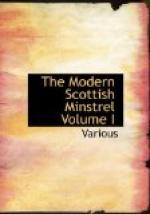The hope of benefiting his enfeebled constitution in a warm climate induced him to revisit Jamaica. As a parting tribute to his friends at Stirling, he published, in 1799, immediately before his departure, a descriptive poem, entitled “The Links of Forth, or a Parting Peep at the Carse of Stirling,” which, regarded as the last effort of a dying poet, obtained a reception fully equal to its merits.
On the oft-disappointed and long unfortunate poet the sun of prosperity at length arose. On his arrival in Jamaica, one of his early friends, Mr John Graham, of Three-Mile-River, settled on him an annuity of L100 a-year; and, in a few months afterwards, they sailed together for Britain, the poet’s health being essentially improved. Macneill now fixed his permanent residence in Edinburgh, and, with the proceeds of several legacies bequeathed to him, together with his annuity, was enabled to live in comparative affluence. The narrative of his early adventures and hardships is supposed to form the basis of a novel, entitled “The Memoirs of Charles Macpherson, Esq.,” which proceeded from his pen in 1800. In the following year, he published a complete edition of his poetical works, in two duodecimo volumes. In 1809, he published “The Pastoral, or Lyric Muse of Scotland,” in a thin quarto volume; and about the same time, anonymously, two other works in verse, entitled “Town Fashions, or Modern Manners Delineated,” and “Bygone Times and Late-come Changes.” His last work, “The Scottish Adventurers,” a novel, appeared in 1812, in two octavo volumes.
The latter productions of Hector Macneill, both in prose and verse, tended rather to diminish than increase his fame. They exhibit the sentiments of a querulous old man, inclined to cling to the habits of his youth, and to regard any improvement as an act of ruthless innovation. As the author of some excellent songs, and one of the most popular ballads in the Scottish language, his name will continue to be remembered.




